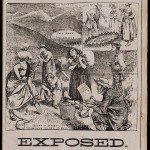In honor of Passion Week, I’m preparing a few special playlists that will gather together some of my favorite songs ever written in any genre. So whether you like great songwriting or whether you’ve just been wondering, “That YankeeGospelGirl, man, what a grump she is! Isn’t there anything she likes?” then you won’t want to miss any of it.
Meanwhile, to kick off the week, I thought I would share an interesting biblical tidbit that sheds light on a key moment in the Last Supper. I discovered it while doing a little research after I’d reviewed the Old Paths Quartet’s latest album. I criticized their song “Stay” for being both poorly written and overly sentimental. While corresponding with someone who sent a nice comment on the review, I was inspired to look up the context for John’s record that “the disciple whom Jesus loved” (assumed to be John himself) was “leaning on Jesus’ breast.” In the song, the writer turns this into some kind of infantile desire to “listen to Jesus’ heartbeat.” To say that I was skeptical of this interpretation would be an understatement. However, I’d always been curious about that phrase. What exactly did it mean? At the suggestion of my correspondent, I’m sharing this quotation from the helpful commentary I found after a few seconds of googling:
The “disciple whom Jesus loved” appears at the Last Supper. A literal translation of the Greek states that he was leaning on Jesus’ breast (Jn 13:23). Some twentieth century people have looked askance at this. In those days, however, it was customary for guests to recline side by side in such a way that the head of one guest was parallel to the chest of the person next to him. If one wished to speak privately to that person, one would move close enough so that one’s head was nearly or actually resting on the neighbor’s chest. This is what happened at the Last Supper, when John was reclining between Jesus and Peter, who was in turn between Judas and John. Jesus had just announced that one of his apostles would betray him. Peter, who was apparently on John‘s left, with his head on John‘s chest, bade him ask Jesus to identify the traitor. John then leaned back so his head was against Jesus’ chest as he asked Him to privately disclose who it was who would betray Him. Jesus took a piece of bread and told John that the man to whom he gave the morsel was the man to watch. He then gave it to Judas, who was on the other side of [John] and thus unable to follow Jesus’ conversation with John. — Bernard Ruffin, The Twelve: The Lives of the Apostles After Calvary, pp. 90-91
Now this author is speculating a bit when he suggests exactly how Peter and Judas were seated. But the point is that, with apologies to anyone who was really touched by that song, this whole idea of John cuddling up to Jesus just because is complete nonsense. In fact, once you understand what’s actually going on, it adds a wonderful dramatic tension to the reveal of Jesus’ betrayer.
It’s worth keeping in mind that Jesus’ life and ministry took place at a particular time and place, historically. We need to be aware that the cultural framework we bring to a given story could be wrong, maybe even seriously wrong. Of course it’s hard to let go of a favorite interpretation once you’ve latched onto it. But wouldn’t you rather understand the Bible the way it was really written, the way it really happened? I know I would.












